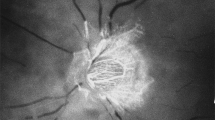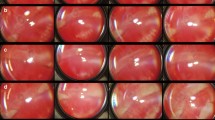Abstract
The effects of vitreous hemorrhages on anterior uveal vessels were studied. Albino rabbits were injected intravitreally with autogenous blood, plasma, RBCs, iron-dextrin, or Ringer's solution. The vascular permeability was assessed by fluorescein iris angiography, carbon labeling and penetration of peroxidase. Following one injection of blood, aqueous flare and fluorescein leakage from the iris were observed for 40 days. Intense vascular carbon labeling in iridial and ciliary processes was present for 1–40 days and weak-to-moderate labeling in the iris for 9–40 days. Repeated blood injections aggravated the vascular response, showing extravasation of peroxidase and carbon labeling of iridial vessels for 92 days. The most severe vascular damage ensued from iron-dextrin and RBCs. Plasma and Ringer's solution gave no reaction. The authors suggest that the iron-containing degradation products of RBCs induce vascular damage in anterior uvea and disruption of blood-aqueous barriers.
Zusammenfassung
Die Auswirkungen von Glaskörperblutungen auf die Gefäße der vorderen Uvea wurden untersucht. Autogenes Blut, Plasma, RBC's, Fe-Dextrin oder Ringer-Lösung wurde in den Glaskörperraum von Albino-Kaninchen injiziert. Die Gefäßpermeabilität wurde an Hand des Irisfluoreszenzangiogramms, von Kohlemarkierung und der Penetration von Peroxidase beurteilt. Nach einer Blutinjektion sahen wir über 40 Tage einen Reizzustand im Kammerwasser und eine Fluorescein-Leckage aus der Iris. Eine intensive vasculäre Kohlemarkierung in Iris- und Ziliarkörperfortsätzen zeigte sich während des 1. bis 40. Tages, und eine schwache bis mäßige Markierung in der Iris während des 9. bis 40. Tages. Wiederholte Blutinjektionen verstärkten die Gefäßreaktion und bewirkten einen Austritt von Peroxidase und eine Kohlemarkierung der Irisgefäße über 92 Tage. Der schwerste vasculäre Schaden wurde durch Fe-Dextrin und RBC's hervorgerufen. Plasma und Ringer-Lösung ergaben keine Reaktion. Es wird vermutet, daß die eisenhaltigen Abbauprodukte roter Blutzellen den vasculären Schaden in der vorderen Uvea und eine Aufhebung der Blut-Kammerwasser-Schranke inducieren.
Similar content being viewed by others
References
Benson WE, Spalter HF (1971) Vitreous hemorrhage: A review of experimental and clinical investigations. Surv Ophthalmol 15:297–311
Cibis PA, Yamashita T (1959) Experimental aspects of ocular siderosis and hemosiderosis. Am J Ophthalmol 48:465–479
Schulze RR (1967) Rubeosis iridis. Am J Ophthalmol 63:487–495
Forrester JV, Lee WR, Williamson J (1978) The pathology of vitreous hemorrhage. Arch Ophthalmol 96:703–709
Cibis PA, Yamashita T, Rodriguez F (1959) Clinical aspects of ocular siderosis and hemosiderosis. Arch Ophthalmol 62:180–187
Yamashita T, Cibis PA (1959) Staining of the retina with saccharated iron oxide. Arch Ophthalmol 61: 698–708
Vannas S (1960) Experimental studies on iron compounds in the eye and their significance for the pathogenesis of hemorrhagic glaucoma. Acta Ophthalmol 38:461–469
Kornacki B, Algvere P, Stefaniak T (1976) Interference filter for colour and black- and-white fluorescein angiography. Acta Ophthalmol 54:369–377
Majno G, Palade GE, Schoefl GI (1961) Studies on inflammation. II. Site of action of histamine and serotonin on vascular tree: Topographic study. J Biophys Biochem Cytol 11:607–626
Ashton N, Cunha-Vaz JG (1965) Effect of histamine on the permeability of the ocular vessels. Arch Ophthalmol 73:211–223
Halpern BN, Benecerraf B, Biozzi G (1953) Quantitative study of the granulopectic activity of the reticuloendothelial system: I. Effect of ingredients present in India ink and of substances affecting blood clotting in vivo on fate of carbon particles administered intravenously in rats, mice, and rabbits. Br J Exp Path 34:426–440
Karnovsky MJ (1967) The ultrastructural basis of capillary permeability studied with peroxidase as a tracer. J Cell Biol 35:213–236
Whitelocke RAF, Eakins KE (1973) Vascular changes in the anterior uvea of the rabbit produced by prostaglandins. Arch Ophthalmol 89:495–499
Uusitalo R, Palkama A, Stjernschantz J (1973) An electron microscopical study of the blood-aqueous barrier in the ciliary body and iris of the rabbit. Exp Eye Res 17:49–63
Grayson M, Tsukahara S, Laties AM (1972) Tissue localization in rabbit and monkey eye of intravenously administered fluorescein. In Shimizu K (ed): Fluorescein Angiography, Tokyo, Igaku Shoin Ltd, pp 235–246
Smith RS, Rudt LA (1975) Ocular vascular and epithelial barriers to microperoxidase. Invest Ophthalmol 14: 556–560
Laties AM, Neufeld AH, Vegge T, Sears ML (1976) Differential reactivity of rabbit iris and ciliary process to topically applied prostaglandin E2 (dinoprostone). Arch Ophthalmol 94:1966–1976
Cotran RS, Suter ER, Majno G (1967) The use of colloidal carbon as a tracer for vascular injury. Vascular Dis 4:107–127
Holmberg Å (1959) The ultrastructure of the capillaries in the ciliary body. Arch Ophthalmol 62:949–951
Rhodin JAG (1962) The diaphragm of capillary endothelial fenestrations. J Ultrastruct Res 6:171–185
Bill A (1968) Capillary permeability to and extravascular dynamics of myoglobin, albumin and gammaglobulin in the uvea. Acta Physiol Scand 73:204–219
Algvere P, Bill A (1979) Drainage of microspheres and RBCs from the vitreous of aphakic and phakic eyes. Arch Ophthalmol 97:1333–1336
Pedersen OØ (1975) Electron microscopic studies on the blood-aqueous barrier of prostaglandin-treated rabbit eyes. II. Iris. Acta Ophthalmol 53:699–709
Algvere P, Jonsson V (1981) Breakdown of blood-aqueous barriers induced by intravitreal iron-dextrin and the inhibitory effect of indomethacin. Ber Dtsch Ophthalmol Ges 78:487–491
Author information
Authors and Affiliations
Rights and permissions
About this article
Cite this article
Algvere, P., Jonsson, V. & Svedbergh, B. Vascular damage in the anterior uvea induced by intravitreal autogenous blood. Albrecht von Graefes Arch. Klin. Ophthalmol. 217, 273–283 (1981). https://doi.org/10.1007/BF00429288
Received:
Issue Date:
DOI: https://doi.org/10.1007/BF00429288




